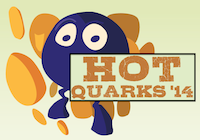Speaker
Mrs
Priyanka Sett
(Bhabha Atomic Research Center)
Description
Strange hadrons are among the most interesting probes of the quark-gluon-plasma,
created in the collisions of heavy ions at relativistic energy.
The PHENIX experiment at RHIC has measured invariant transverse momentum spectra and nuclear modification factor ($R_{AA}$) of strange mesons K^{*0} and K^{0}_{S}, in
$p$+$p$, $d$+Au and Cu+Cu collisions at center of mass energy 200 GeV.
The transverse momentum range of these measurements spans from 1.1 to 8.5 GeV/c
for $K^{*0}$ and from 2 to 13 GeV/c for $K^{0}_{S}$.
Similar to the other light-quark mesons measurements,
both these strange mesons show no cold-nuclear-matter effects in the measured $p_T$
range in $d$+Au collisions. The nuclear modification factor ($R_{dAu}$) $\approx$ 1 and is almost constant as a function of $p_{T}$.
It is interesting to have the quantitative study of ($R_{CuCu}$) of the strange
mesons ($K^{*0}$, $K^{0}_{S}$) in heavy ion collisions as a function of centrality.
In case of peripheral collisions, no suppression is registered with respect to the $p$+$p$ yields scaled with number of binary collisions. Where as in central collisions, both mesons suffer substantial amount of suppression at high $p_T$ ($>$ 5 GeV/c), which is similar to the suppression suffered by light-quark mesons.
In the intermediate $p_T$ range (2 $<$ $p_T$ $<$ 5 (GeV/c)), the strange mesons are less suppressed than the light-quark meson ($\pi^{0}$) and more suppressed than the baryons ($p$, $\bar{p}$).
Authors
Boris Hippolyte
(Institut Pluridisciplinaire Hubert Curien (FR))
Mrs
Priyanka Sett
(Bhabha Atomic Research Center)
